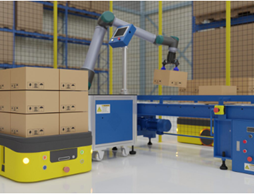Top 7 Applications for Automated Palletising in the Food Industry
29-05-2023
The British Automation and Robotic Association (BARA) reported that sales of robotics to food and drink manufacturers was 21% up in 2020 from the previous year. Most of the units helped improve packaging operations across food manufacturing plants.
Since products are usually uniform at the sorting and packaging stage, it is easier to handle them with automation. One of the machines procured for these processes is an automated palletiser.
Palletising involves loading an object in a defined pattern. But what are the top 7 applications of palletising in the food industry in the UK? Read on to find out.
1. Pick and Place Randomly Oriented Foods
If a company uses automated food processing machines, it is likely to end up with randomly distributed and oriented products. Picking and placing these products in the right order can take a lot of time when done by hand. That is why an automated palletiser is important.
Automated palletisers can help stack up products. When used with robots, they can identify, align and place products.
Unlike fixturing, which requires a lot of space, palletising takes less space. The technique can also respond to changes in products.
Stacking a bag or box filled with food onto a pallet is safer. The goods will not deteriorate during handling.
A good palletiser will maintain control of the product throughout the packing cycle. It will hold the goods by the bottom, simulating the movement of a hand. Its main emphasis is on automated palletising.
With a selected product in the pallet, the machine will drag it to the desired position. As a result, it reduces the chances of having randomly positioned goods. It also allows for a compact and stable pallet.
2. Handling Baked Goods
Large pans help hold mass-produced baked goods in the oven. Removing the baked items from the pans by hand once they are ready is quite tiring. The process may also interfere with the production timeline since it takes time.
Robotics can help remove the goods and prepare them for packaging. They pick up whole trays of baked items using a depanning tool. And then small pins or a vacuum will help grasp the goods.
After depanning the baked items, one can introduce a palletiser to help stack and organise them. Palletising helps reduce downtime in the process.
A robotic palletising system can reduce delays in a bakery. It ensures that the goods are ready as soon as customers need them. Provided they are out of the oven, customers will not wait in line for longer periods for a company to process their orders.
Automated palletisers are a great investment for bakeries that want to expand their operations. They allow one to stack and organise bulk orders before shipping them.
3. Raw Food Handling
Raw foods tend to have uneven sizes and shapes when packed. Stacking them by hand is labour-intensive. It may also deteriorate them if the bags or boxes fall.
One will need an automated palletiser to stack and organise them. The machine will relieve the workers of the burden of doing repetitive tasks. It will also reduce the likelihood of accidents or injuries when the goods fall.
There is an option to program the equipment for different purposes. One can do it to stack the raw foods based on weight or volume. This way, it is easier to sort the goods for shipping.
Palletising also makes inventorying convenient. The process stacks large quantities of products together to organise them. Workers can then take count of the products.
Depending on the size of the food business, one may invest in a custom-made palletiser. The machine will come with the features needed for handling packed raw foods.
4. Unitise Goods for Different Purposes
Unitising loads can help one handle a group of items as one unit instead of separate units. The best equipment for this task is an automated palletiser. It allows manufacturers to sort goods in groups for specific purposes.
For instance, if they have customised packages for different customers, they can organise them with this machine. Their customers will then receive the goods according to the groups they set.
A palletiser also helps optimise the amount of space on the truck. As they palletise the goods, they can reduce the number of loads in each truck.
Palletising is a great way to condense several products in a single unit. It reduces the cost of storage and shipping. This way, a business gets to save a large amount of money.
Lastly, since palletised goods are uniformly rectangular or square, they are easy to stack. It also takes less work to stack them for any purpose.
5. Stacking Boxes of Beverages and Delicate Foods
A lot of work goes into grouping cases or boxes of beverages and delicate foods. Workers have to take caution when handling boxes made of glass. They also need to ensure that the cases or boxes have seals to prevent contamination.
These tasks are simpler when one introduces an automated palletiser. The machine can safely stack boxes of delicate food items such as eggs. It can also organise large quantities of boxes containing beverages.
Palletising can help arrange carton boxes or bags in uniform layers. The uniform layers are easy to sift through when doing an inventory check.
Automated palletisers come with intelligent features to make the work more efficient. They are flexible and fast.
If one has a column palletiser at the plant, expect it to use the conveyor to send the packed goods to a designated area. It can also repeat the process until it sorts out all the products.
6. Prepare Products for Shipping
For efficient shipping, palletising relies on factors such as consistency and speed. Accuracy and regularity also affect the process.
If the process is inconsistent, one may end up with sloppy shipments. It may also lead to lost or damaged goods during shipping. An automated palletiser can help avoid these obstacles.
Automated palletisers operate at a strict regular cadence. As such, they can help prepare shipments without errors. One can count on them to optimise the pre-shipping process.
Workers can palletise goods faster when needed. But companies cannot rely on them to maintain the same consistency throughout the job. So, they will need an automated palletiser for this purpose.
The machine can also help place boxes and bags in the right order. This way, their contents will not shift when they are ready for shipping. When human workers sort the boxes, their accuracy may reduce due to fatigue.
Automated palletisers perform the same task without minimal intervention. They can help the workers ensure that the packages are in the right place.
Manufacturers can also use them to simplify the workers’ duties. This way, their staff will have time to focus on other important aspects of the business.
Thanks to their automated features, the machines are easy to program. They can train their workers on how to use them when preparing products for shipping.
For a food company, delivering goods to customers in an efficient manner is important. One also needs to ensure that the packages are in the correct order to avoid confusion. For more efficient stacking and sorting, they should use an automated palletiser.
Warehousing
One of the biggest challenges food and beverage companies face is warehousing. Without the right equipment, warehousing processes can fail. Processed and frozen foods can mix with contaminants if the workers fail to handle them with care at the warehouse.
An automated palletising system can help prevent these problems. The machine will help one stack and organise goods before storing them. It also prevents cases of mixing up incompatible products together.
A typical warehouse has several means for storing food. But before the goods get there, they have to pass through a palletiser. This way, one will avoid putting non-refrigerated items in the freezer.
Automating warehousing processes can make a company competitive. After packing the food items into cages or pallets, they should find an automated machine to transport them. Robotic palletisers can handle large numbers of these products without breaking down.
Automated palletising machines can have custom features for warehousing. Companies can get a personalised one to match the needs of a warehouse. The machine can accommodate their needs even when the warehouse expands.
Good robotic palletisers can handle rigid packaging containers in a warehouse. These containers may include open-top boxes, bags, totes, trays and cases.
The multiple configurations on the machine can help it adapt to certain quantities. They also allow it to operate at a given pallet format or a desired rate. These controls help make the warehouse more efficient.
Top 7 Applications for Automated Palletising in the Food Industry
Modern automated palletisers can improve handling, cycle time and stability in production processes. As they do this, they reduce the risk of injury to workers and costly breakages. This guide covered the top 7 applications for palletising in the food industry in detail.
If a company is looking for a robotics and automation provider, SP Automation and Robotics is here to help. Our solutions ensure coordination and flexibility in sorting and packing processes. They should check out the service pages on our site and contact us with their enquiry.
Follow us on LinkedIn to stay updated. Read more about our automation here…
• Benefits of Automation
• Benefits of Machine Vision Automation
• Feeding & Handling Automation
• Automated Medical Device & Assembly Systems
• Industrial Automation
• Part Handling and Part Feeding Vibratory Bowl
• Cost of Industrial Automation
• Advantages & Disadvantages of Robotic Automation
• Medical Device Automation
• Bowl Feeder vs. a Vision Guider Feed System
• Special Purpose Machinery





